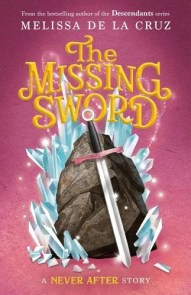Just in time for the holidays, check out these new releases! Make sure to put them on your Wish List…or pick up a copy or two for your favorite middle-grade readers.
Written by Leah Cypess, Delacorte Press, December 5 release
For as long as Mera can remember, she and her sister Darina have feared the Beast who lurks in the castle above their village. On countless nights they have locked themselves into their home while the Beast led his hounds on the Wild Hunt, preying on anything in his path.
Mercy Watson is Missing! Tales from Deckawoo Drive
Written by Kate DiCamillo, Illustrated by Chris Van Dusen, Candlewick Press, December 5 release
When Mercy Watson the pig goes missing, all of Deckawoo Drive is in an uproar. The Watsons are inconsolable, and the local police, fire, and animal control departments are no help whatsoever. Bossy neighbor Eugenia Lincoln is not quite as sad as she might be, but thankfully her sister, Baby Lincoln, has the idea to hire a private investigator. Granted, Percival Smidgely, PI, may be more bumbler than gumshoe, but his pigeon, Polly, is there to point the way. Meanwhile, Frank and Stella Endicott and Stella’s friend Horace Broom are ready to do some investigating of their own. Will the clever neighborhood sleuths manage to follow the trail of hoofprints–and a certain overwhelmingly enticing scent–and recover their porcine wonder? With deftly paced narrative comedy, visual slapstick, abundant artwork in both black and white and full color, and warm affection for their cast of characters, Kate DiCamillo and Chris Van Dusen bring us a highly satisfying, extra-special series finale that rewards loyal fans–and invites new readers to explore the stories that came before.
Return to the land of Never After, where real life and fairy tales collide, in book four of New York Times-bestselling author Melissa de la Cruz’s hit middle grade series.
To save her mother from Olga’s evil clutches, Filomena and her friends will set off for new lands and new adventures. Without a moment to lose, Filomena must travel to the legendary land of Camelot to find the sword of Excalibur – the only thing that can save Fil’s mother from Olga’s mysterious illness that has poisoned her body.
But Camelot is not all that it seems. Fil and the crew quickly realize that there is another fairy tale that has taken hold in the land of Arthurian Legend. . . that of the Wizard of Oz! With the help (and hindrance) of the Wicked Witches of the East and West, lions and tigers and bears will surely be the least of Fil and the gang’s troubles.
As the League of Seven follows the yellow brick road to retrieve the sword and complete their most important quest yet, they find nothing will thwart the ogres and their mission to destroy Never After. In a land where nothing is truly as it seems, will Fil and the League of the Seven survive the witch’s tests? Or will Olga’s perilous plans rip Fil’s mother away from her forever?
DK Publishing December 5 release
Packed with striking photography, Eyewitness Fossil explores the creatures and plants that lived long ago.
Become an eyewitness to the natural treasures found in rocks in this picture-led reference guide that will take you on a visual tour of all things fossils. Children will be mesmerized by the bones, teeth, and plants from long ago that have all been turned to rock.
This beautifully illustrated guide for kids aged 9+ gives an insight into how paleontologists learn about ancient life forms. Striking photographs, detailed diagrams, and lots of examples of fossils help you to learn what can be discovered around the world and why some fossils lead to new discoveries about the past.
Written by Alfonso Font, Dark Horse Books, December 19 release
In a house of wonder, two children will learn life lessons through stories spanning across time.
During his first stay with his uncle, a boy discovers the magical world that is his uncle’s house. Surrounded by eclectic antiques, a vast library of books, strange objects, and whimsical animals, he is overcome with curiosity. Here, he meets a girl who shares his sense of wonder. With his uncle’s wisdom and an enchanted gift, the children will learn important life lessons through the diverse experiences of people throughout time—from common hikers encountering an unusual creature, to a general making the final decision to end a war, and many more!
Robert Winston: The Story of Science
Written by Robert Winston, DK Publishing, December 12 release
Delve into the stories of history’s most influential scientific experiments, inventions and life-changing discoveries that have impacted our understanding and changed the world in this science book for kids aged 7-9.Robert Winston’s The Story of Science will teach children about the incredible world of science through fascinating facts, innovative inventions, and daring discoveries. Learn how random accidents have led to some of the greatest findings our world has ever seen, and how anybody who dares to dream can be successful.








 We are delighted to interview author Cindy Blobaum for our Ice and Snow theme this month!
We are delighted to interview author Cindy Blobaum for our Ice and Snow theme this month!


 Jennifer Swanson is the award-winning author of 45+ books for kids, mostly about STEM, and also the creator and cohost of the
Jennifer Swanson is the award-winning author of 45+ books for kids, mostly about STEM, and also the creator and cohost of the 